2005 BMW Z4 ROADSTER 3.0I tires
[x] Cancel search: tiresPage 5 of 120
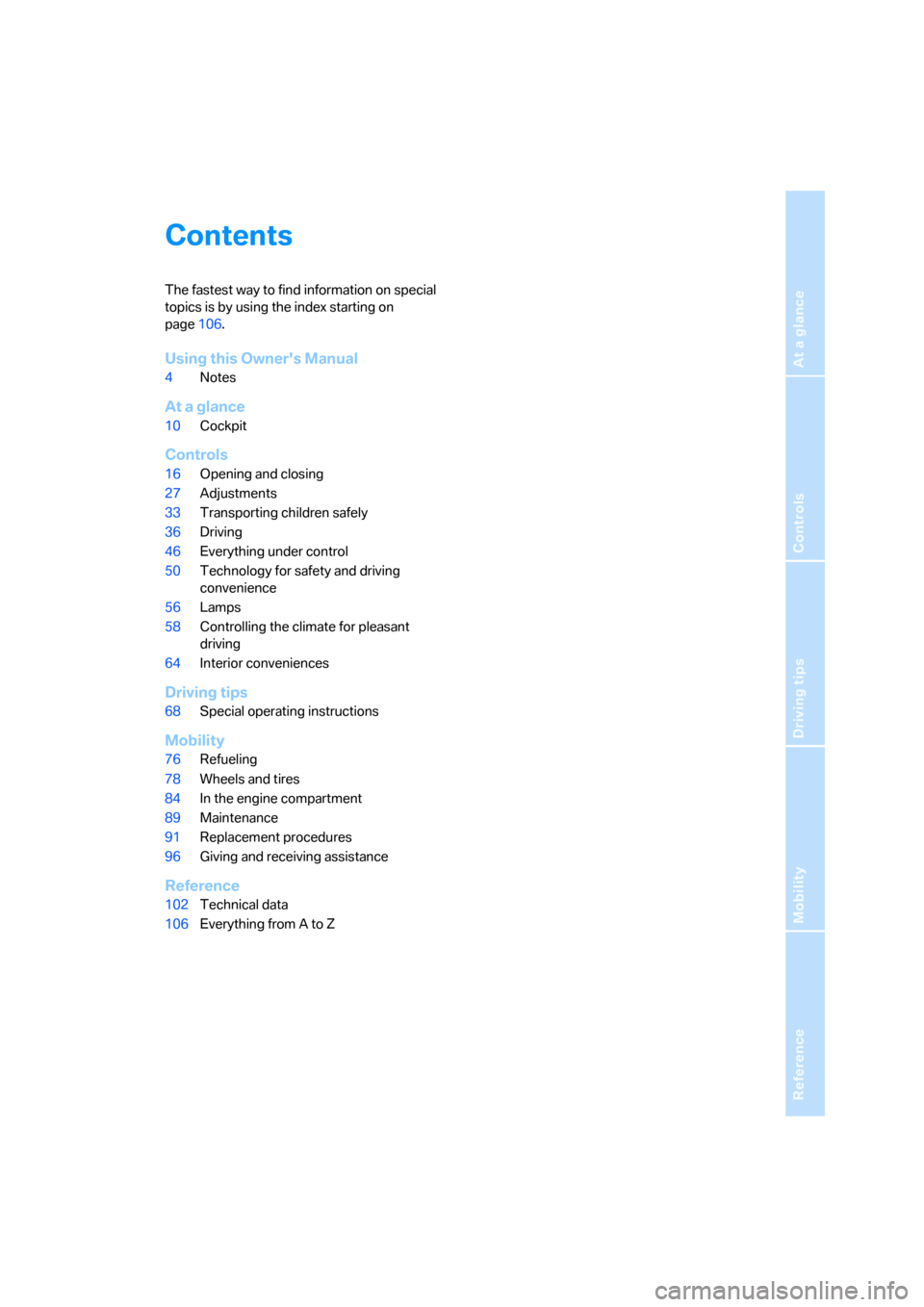
Reference
At a glance
Controls
Driving tips
Mobility
Contents
The fastest way to find information on special
topics is by using the index starting on
page106.
Using this Owner's Manual
4Notes
At a glance
10Cockpit
Controls
16Opening and closing
27Adjustments
33Transporting children safely
36Driving
46Everything under control
50Technology for safety and driving
convenience
56Lamps
58Controlling the climate for pleasant
driving
64Interior conveniences
Driving tips
68Special operating instructions
Mobility
76Refueling
78Wheels and tires
84In the engine compartment
89Maintenance
91Replacement procedures
96Giving and receiving assistance
Reference
102Technical data
106Everything from A to Z
Page 54 of 120
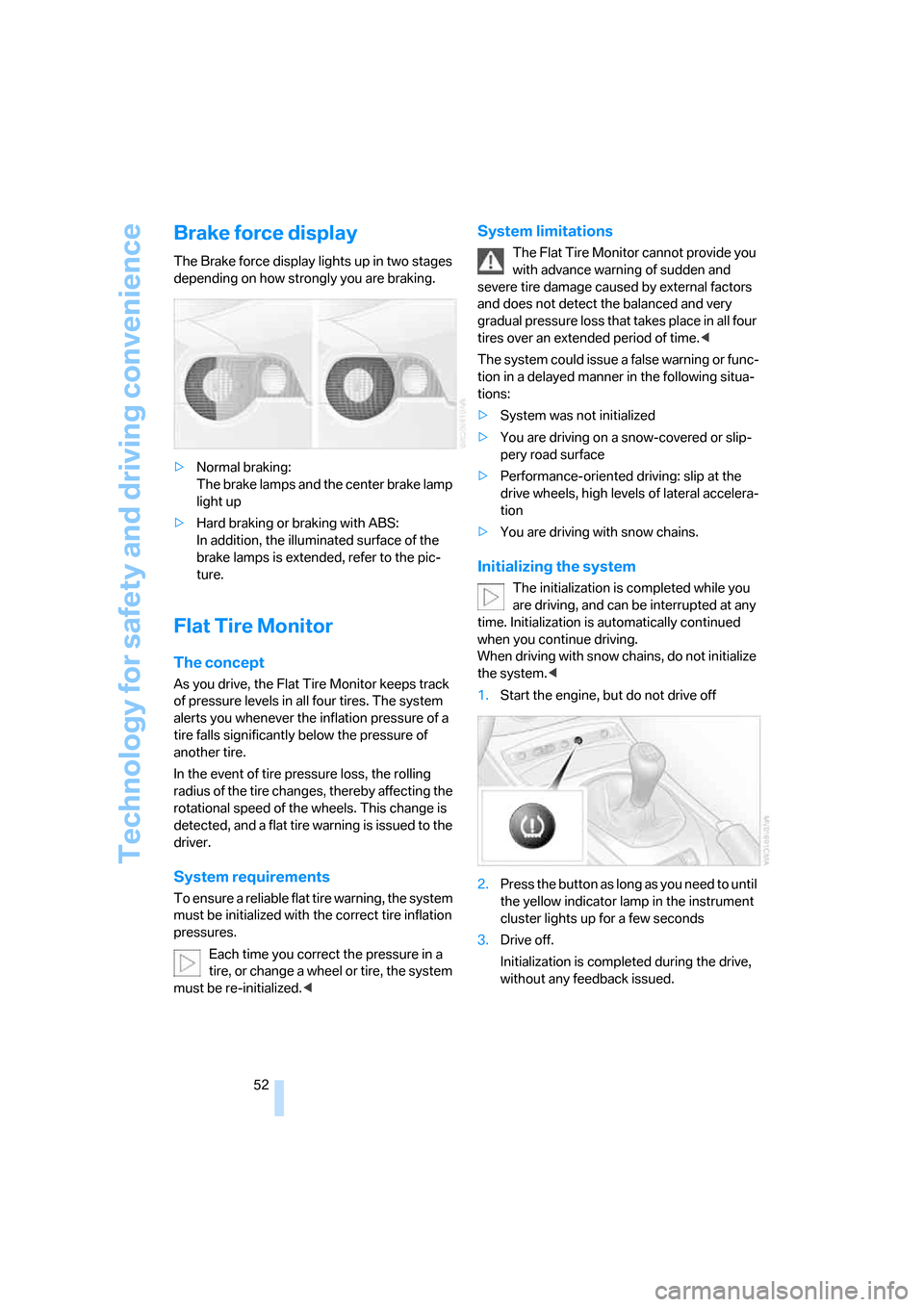
Technology for safety and driving convenience
52
Brake force display
The Brake force display lights up in two stages
depending on how strongly you are braking.
>Normal braking:
The brake lamps and the center brake lamp
light up
>Hard braking or braking with ABS:
In addition, the illuminated surface of the
brake lamps is extended, refer to the pic-
ture.
Flat Tire Monitor
The concept
As you drive, the Flat Tire Monitor keeps track
of pressure levels in all four tires. The system
alerts you whenever the inflation pressure of a
tire falls significantly below the pressure of
another tire.
In the event of tire pressure loss, the rolling
radius of the tire changes, thereby affecting the
rotational speed of the wheels. This change is
detected, and a flat tire warning is issued to the
driver.
System requirements
To ensure a reliable flat tire warning, the system
must be initialized with the correct tire inflation
pressures.
Each time you correct the pressure in a
tire, or change a wheel or tire, the system
must be re-initialized.<
System limitations
The Flat Tire Monitor cannot provide you
with advance warning of sudden and
severe tire damage caused by external factors
and does not detect the balanced and very
gradual pressure loss that takes place in all four
tires over an extended period of time.<
The system could issue a false warning or func-
tion in a delayed manner in the following situa-
tions:
>System was not initialized
>You are driving on a snow-covered or slip-
pery road surface
>Performance-oriented driving: slip at the
drive wheels, high levels of lateral accelera-
tion
>You are driving with snow chains.
Initializing the system
The initialization is completed while you
are driving, and can be interrupted at any
time. Initialization is automatically continued
when you continue driving.
When driving with snow chains, do not initialize
the system.<
1.Start the engine, but do not drive off
2.Press the button as long as you need to until
the yellow indicator lamp in the instrument
cluster lights up for a few seconds
3.Drive off.
Initialization is completed during the drive,
without any feedback issued.
Page 55 of 120
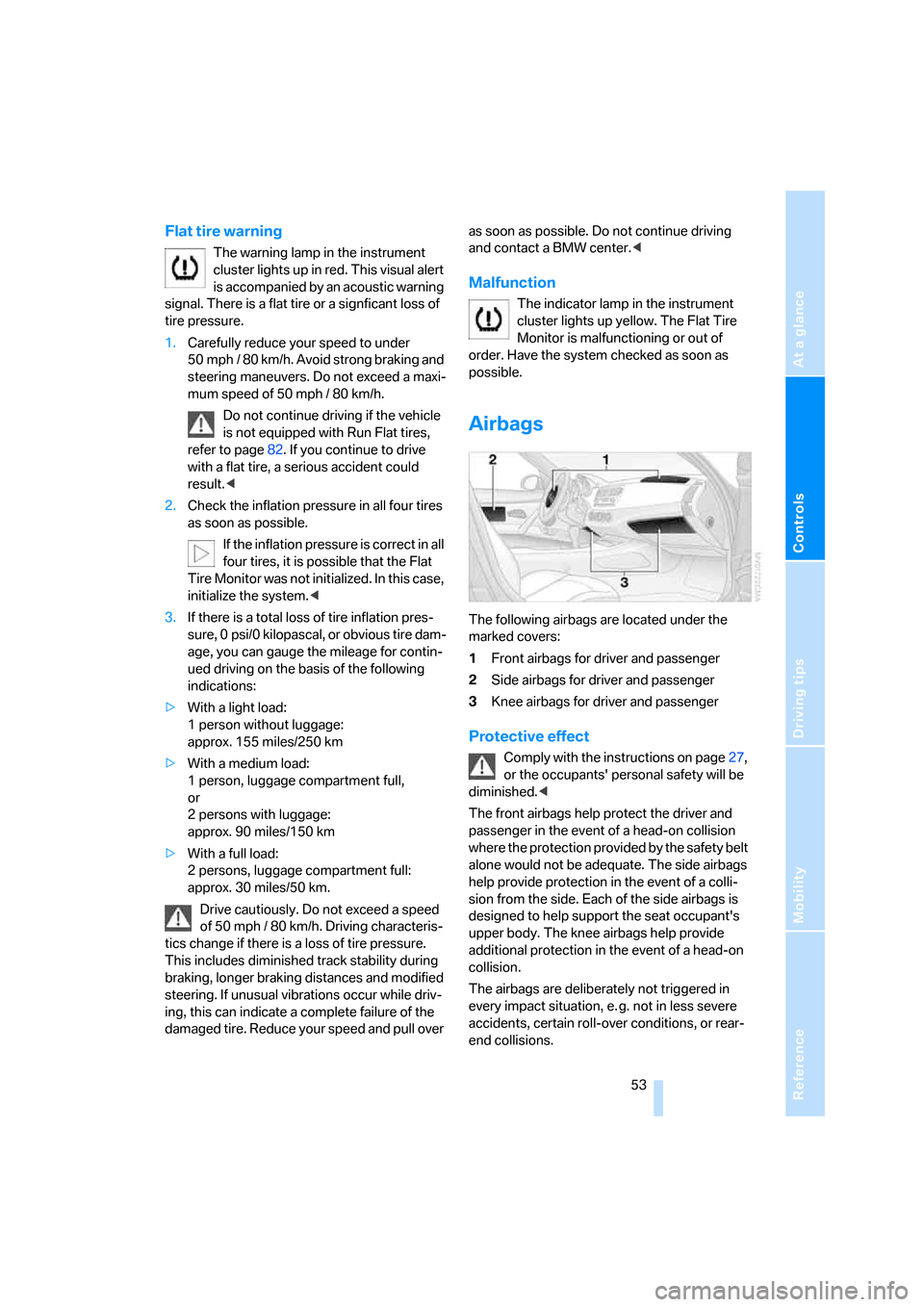
Reference
At a glance
Controls
Driving tips
Mobility
53
Flat tire warning
The warning lamp in the instrument
cluster lights up in red. This visual alert
is accompanied by an acoustic warning
signal. There is a flat tire or a signficant loss of
tire pressure.
1.Carefully reduce your speed to under
50 mph / 80 km/h. Avoid strong braking and
steering maneuvers. Do not exceed a maxi-
mum speed of 50 mph / 80 km/h.
Do not continue driving if the vehicle
is not equipped with Run Flat tires,
refer to page82. If you continue to drive
with a flat tire, a serious accident could
result.<
2.Check the inflation pressure in all four tires
as soon as possible.
If the inflation pressure is correct in all
four tires, it is possible that the Flat
Tire Monitor was not initialized. In this case,
initialize the system.<
3.If there is a total loss of tire inflation pres-
sure, 0 psi/0 kilopascal, or obvious tire dam-
age, you can gauge the mileage for contin-
ued driving on the basis of the following
indications:
>With a light load:
1 person without luggage:
approx. 155 miles/250 km
>With a medium load:
1 person, luggage compartment full,
or
2 persons with luggage:
approx. 90 miles/150 km
>With a full load:
2 persons, luggage compartment full:
approx. 30 miles/50 km.
Drive cautiously. Do not exceed a speed
of 50 mph / 80 km/h. Driving characteris-
tics change if there is a loss of tire pressure.
This includes diminished track stability during
braking, longer braking distances and modified
steering. If unusual vibrations occur while driv-
ing, this can indicate a complete failure of the
damaged tire. Reduce your speed and pull over as soon as possible. Do not continue driving
and contact a BMW center.<
Malfunction
The indicator lamp in the instrument
cluster lights up yellow. The Flat Tire
Monitor is malfunctioning or out of
order. Have the system checked as soon as
possible.
Airbags
The following airbags are located under the
marked covers:
1Front airbags for driver and passenger
2Side airbags for driver and passenger
3Knee airbags for driver and passenger
Protective effect
Comply with the instructions on page27,
or the occupants' personal safety will be
diminished.<
The front airbags help protect the driver and
passenger in the event of a head-on collision
where the protection provided by the safety belt
alone would not be adequate. The side airbags
help provide protection in the event of a colli-
sion from the side. Each of the side airbags is
designed to help support the seat occupant's
upper body. The knee airbags help provide
additional protection in the event of a head-on
collision.
The airbags are deliberately not triggered in
every impact situation, e. g. not in less severe
accidents, certain roll-over conditions, or rear-
end collisions.
Page 70 of 120

Special operating instructions
68
Special operating instructions
Break-in procedures
Moving parts need to be given some time until
they can interact smoothly with one another. To
ensure that your vehicle provides maximum
economy throughout a long service life, we
request that you observe the following:
Engine and differential
Up to 1,200 miles/2,000 km:
Drive at varying engine and road speeds, but do
not exceed the following engine or road speed:
4,500 rpm / 4,500/min or 100 mph / 160 km/h.
Obey your local and state maximum speed lim-
its.
Refrain from using full throttle and avoid press-
ing the accelerator beyond the kickdown point.
After you have driven 1,200 miles/2,000 km,
you can gradually increase the engine or road
speeds.
Sequential manual gearbox SMG
Up to 1,200 miles/2,000 km:
Do not use the acceleration assistant during the
break-in period.
Tires
Due to technical factors associated with their
manufacture, tires do not achieve their full trac-
tion potential until an initial break-in period has
elapsed. You should therefore drive with extra
caution during the first 200 miles/300 km.
Obey your local and state maximum speed lim-
its.
When the vehicle is operated on wet or
slushy roads, a wedge of water may form
between the tire and the road surface. This phe-
nomenon is referred to as hydroplaning and can
lead to partial or complete loss of traction, vehi-
cle control and braking effectiveness. Reduce
your speed on wet roads.<
Brake system
Approx. 300 miles/500 km must elapse before
the brake pads and rotors achieve their optimal
surface and wear pattern.
To break in the separate parking brake drums,
apply the parking brake lightly when coasting to
a standstill – at a traffic signal, for instance; use
caution to avoid posing a danger to other road
users.
To avoid corrosion, repeat this procedure from
time to time.
The brake lamps do not come on when the
parking brake is set.
Vacuum for the brake system servo unit
on your BMW is available only when the
engine is running. When you move the car with
the engine off, e.g. by towing, substantially
higher levels of pedal force will be required to
brake the vehicle.<
Clutch
The clutch will achieve its optimal functionality
after approx. 300 miles/500 km. Shift gears
carefully during the break-in period.
After replacing components
Follow the same break-in procedure again if any
of the components mentioned above have to be
replaced in the future.
Driving notes
Close the luggage compartment lid
Operate the vehicle only when the lug-
gage compartment lid is completely
closed, otherwise exhaust fumes could pene-
trate into the interior of the vehicle.<
Should it be absolutely necessary to operate
the vehicle with the luggage compartment lid
open and with the convertible top closed:
Page 71 of 120

Reference
At a glance
Controls
Driving tips
Mobility
69
1.Close all windows
2.Increase the air supply from the air condi-
tioner or automatic climate control to a high
level. Refer to page58 or61.
Hot exhaust system
High temperatures occur with every vehi-
cle equipped with a catalytic converter.
Heat shields are installed adjacent to some sec-
tions of the exhaust system. Never remove
these shields; do not apply undercoating to
their surfaces. When driving, standing at idle
and parking the vehicle, take care to avoid con-
tact between the hot exhaust system and flam-
mable materials, e.g. hay, leaves, grass, etc.
Such contact could lead to a fire, resulting in
serious personal injury and property damage.<
Hydroplaning
When driving on wet or slushy roads,
reduce vehicle speed. If you do not, a
wedge of water may form between the tires and
the road surface. This phenomenon can lead to
partial or complete loss of traction, vehicle con-
trol and braking effectiveness.<
Driving through water
Do not drive through water on the road if it
is deeper than 1 ft/30 cm, and then only at
walking speed. Otherwise, the vehicle's engine,
the electrical systems and the transmission
may be damaged.<
Use the parking brake on inclines
On inclines, keep the vehicle from rolling
by using the parking brake rather than by
slipping the clutch, which would lead to a high
degree of clutch wear.<
Braking safely
Your BMW is equipped with ABS as a standard
feature. If you are in a situation which requires
full braking, it is best to brake using maximum
brake pressure: panic stop. Since the vehicle
maintains steering responsiveness, you can still
avoid possible obstacles with a minimum of
steering effort.Pulsation at the brake pedal combines with
sounds from the hydraulic circuits to indicate to
the driver that ABS is in its active mode.
Wet roads
If the roads are wet or if there is heavy rain, it is
advisable to gently press the brakes for a brief
moment every few miles/kilometers. Watch
traffic conditions to ensure that this maneuver
does not endanger other road users. The
resulting heat dries the brake rotors and brake
pads. Immediate braking force is then available
if necessary.
Inclines
To prevent overheating and, as a result,
diminished braking effectiveness, drive
down long or steep downhill grades in a gear
which requires the least braking. Otherwise,
even light but consistent pedal pressure can
lead to high temperatures, brake wear and pos-
sibly even brake failure.<
The braking power of the engine can be further
enhanced by downshifting the automatic trans-
mission in manual mode, if necessary, into first
gear; refer to pages39 and41. This prevents an
excessive load on the brakes.
Do not coast with the clutch depressed or
with the transmission or selector lever in
Neutral. Do not coast with the engine switched
off. Otherwise, the engine provides no braking
effect while the transmission is in idling posi-
tion, and there is no power-assist for braking or
steering when the engine is off.
Floor mats, floor carpets or other objects must
not be in the area near the brake or accelerator
pedal, as this could impair the movement of the
pedals.<
Corrosion on the brake rotors
Limited vehicle use, extended periods with the
vehicle parked or in storage, and operating con-
ditions in which braking is restricted to gentle,
low-pressure applications will all increase the
tendency for corrosion to form on the rotors and
contamination to accumulate on the brake
pads. This occurs because the minimal pres-
Page 72 of 120
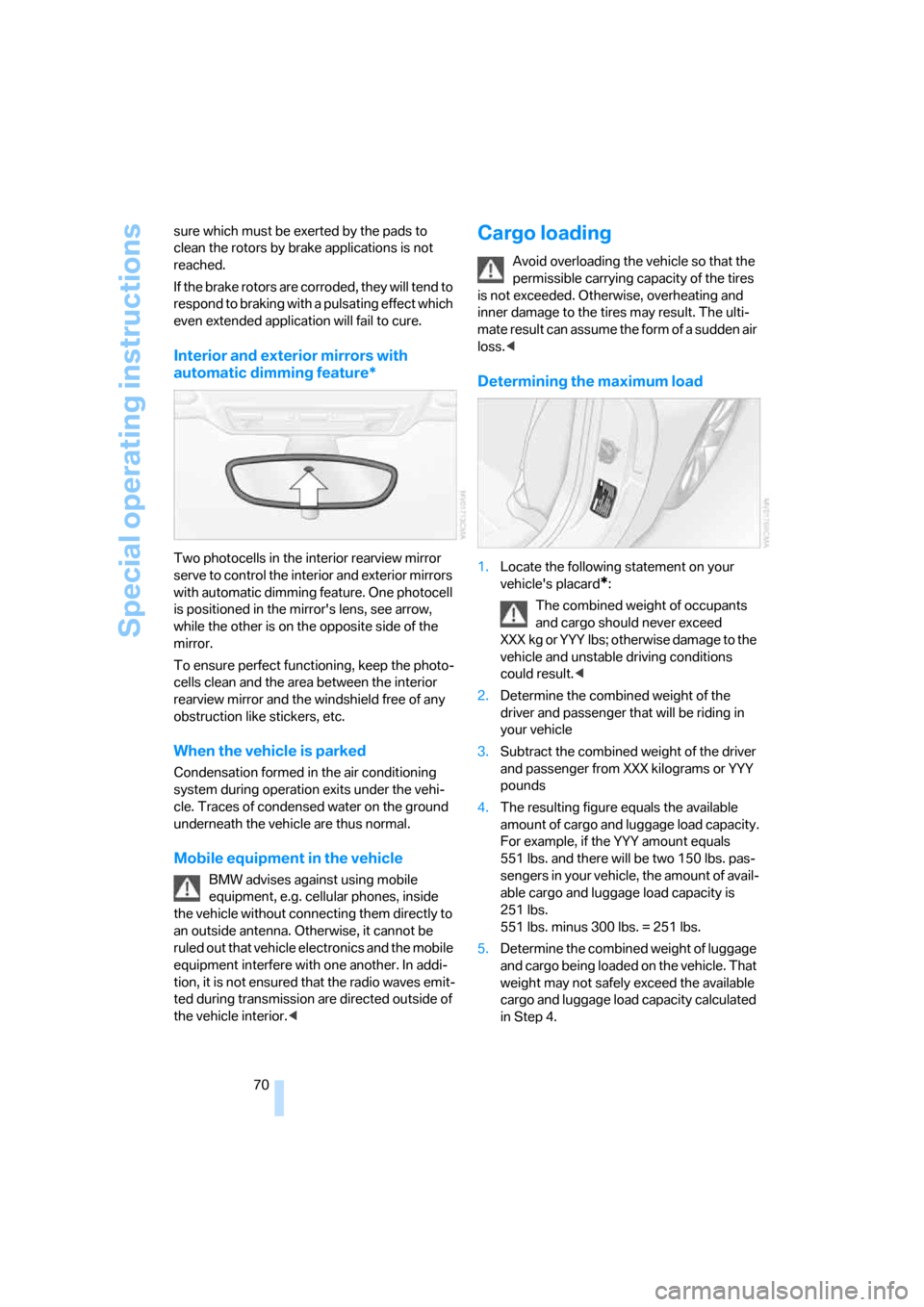
Special operating instructions
70 sure which must be exerted by the pads to
clean the rotors by brake applications is not
reached.
If the brake rotors are corroded, they will tend to
respond to braking with a pulsating effect which
even extended application will fail to cure.
Interior and exterior mirrors with
automatic dimming feature*
Two photocells in the interior rearview mirror
serve to control the interior and exterior mirrors
with automatic dimming feature. One photocell
is positioned in the mirror's lens, see arrow,
while the other is on the opposite side of the
mirror.
To ensure perfect functioning, keep the photo-
cells clean and the area between the interior
rearview mirror and the windshield free of any
obstruction like stickers, etc.
When the vehicle is parked
Condensation formed in the air conditioning
system during operation exits under the vehi-
cle. Traces of condensed water on the ground
underneath the vehicle are thus normal.
Mobile equipment in the vehicle
BMW advises against using mobile
equipment, e.g. cellular phones, inside
the vehicle without connecting them directly to
an outside antenna. Otherwise, it cannot be
ruled out that vehicle electronics and the mobile
equipment interfere with one another. In addi-
tion, it is not ensured that the radio waves emit-
ted during transmission are directed outside of
the vehicle interior.<
Cargo loading
Avoid overloading the vehicle so that the
permissible carrying capacity of the tires
is not exceeded. Otherwise, overheating and
inner damage to the tires may result. The ulti-
mate result can assume the form of a sudden air
loss.<
Determining the maximum load
1.Locate the following statement on your
vehicle's placard
*:
The combined weight of occupants
and cargo should never exceed
XXX kg or YYY lbs; otherwise damage to the
vehicle and unstable driving conditions
could result.<
2.Determine the combined weight of the
driver and passenger that will be riding in
your vehicle
3.Subtract the combined weight of the driver
and passenger from XXX kilograms or YYY
pounds
4.The resulting figure equals the available
amount of cargo and luggage load capacity.
For example, if the YYY amount equals
551 lbs. and there will be two 150 lbs. pas-
sengers in your vehicle, the amount of avail-
able cargo and luggage load capacity is
251 lbs.
551 lbs. minus 300 lbs. = 251 lbs.
5.Determine the combined weight of luggage
and cargo being loaded on the vehicle. That
weight may not safely exceed the available
cargo and luggage load capacity calculated
in Step 4.
Page 77 of 120
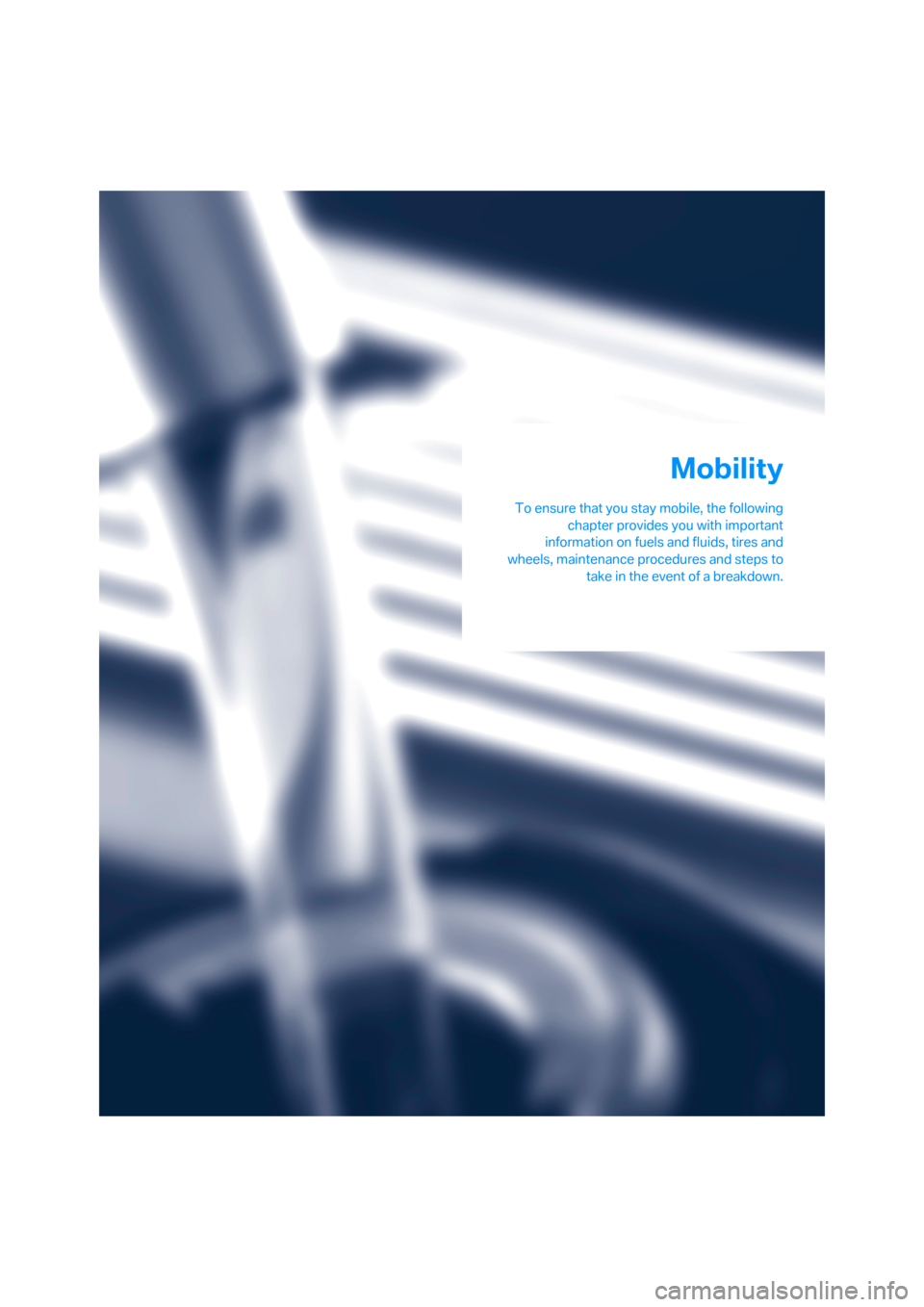
Mobility
To ensure that you stay mobile, the following
chapter provides you with important
information on fuels and fluids, tires and
wheels, maintenance procedures and steps to
take in the event of a breakdown.
Mobility
Page 80 of 120
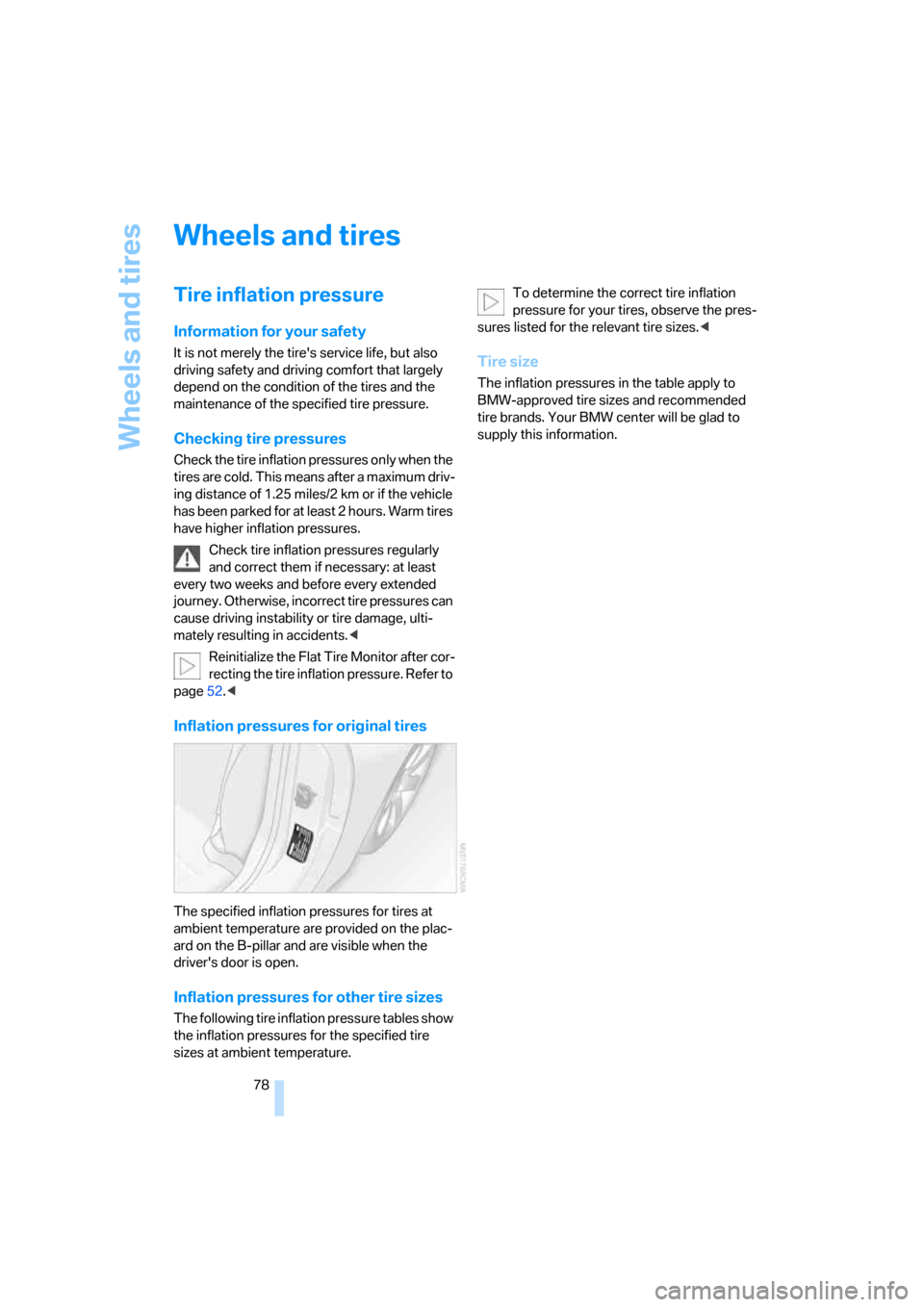
Wheels and tires
78
Wheels and tires
Tire inflation pressure
Information for your safety
It is not merely the tire's service life, but also
driving safety and driving comfort that largely
depend on the condition of the tires and the
maintenance of the specified tire pressure.
Checking tire pressures
Check the tire inflation pressures only when the
tires are cold. This means after a maximum driv-
ing distance of 1.25 miles/2 km or if the vehicle
has been parked for at least 2 hours. Warm tires
have higher inflation pressures.
Check tire inflation pressures regularly
and correct them if necessary: at least
every two weeks and before every extended
journey. Otherwise, incorrect tire pressures can
cause driving instability or tire damage, ulti-
mately resulting in accidents.<
Reinitialize the Flat Tire Monitor after cor-
recting the tire inflation pressure. Refer to
page52.<
Inflation pressures for original tires
The specified inflation pressures for tires at
ambient temperature are provided on the plac-
ard on the B-pillar and are visible when the
driver's door is open.
Inflation pressures for other tire sizes
The following tire inflation pressure tables show
the inflation pressures for the specified tire
sizes at ambient temperature.To determine the correct tire inflation
pressure for your tires, observe the pres-
sures listed for the relevant tire sizes.<
Tire size
The inflation pressures in the table apply to
BMW-approved tire sizes and recommended
tire brands. Your BMW center will be glad to
supply this information.